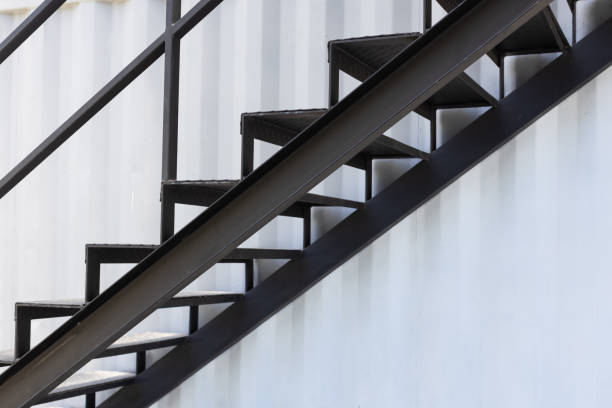Introduction to Exterior Metal Stairs
Exterior spaces require not only aesthetic features but also practical elements that improve accessibility, safety, and style. Among these, exterior metal stairs stand out as one of the most reliable solutions. They combine strength, longevity, and versatility while enhancing the overall architectural appeal of a building.
Whether used for residential homes, commercial complexes, or industrial facilities, metal stairs remain a preferred choice due to their durability and design flexibility. Moreover, they can be customized to suit various outdoor needs, from fire escapes and balconies to gardens and entryways.
This article provides a comprehensive look into exterior metal stairs. You will learn about materials, benefits, styles, installation considerations, maintenance tips, and buying guides.
Why Choose Exterior Metal Stairs?
Selecting outdoor staircases requires careful planning because they face constant exposure to weather elements. Here are the main reasons property owners prefer metal stairs:
- Durability – Metals such as steel, aluminum, and wrought iron withstand wear and tear.
- Weather resistance – With protective coatings, these stairs resist rust and corrosion.
- Safety – Designed with railings, anti-slip surfaces, and structural stability.
- Design versatility – Available in contemporary, classic, or industrial styles.
- Cost-effectiveness – Long-lasting with minimal maintenance requirements.
- Space efficiency – Compact options like spiral designs fit small outdoor areas.
In comparison to wood or concrete, metal offers unmatched strength and adaptability, making it ideal for exterior applications.
Types of Exterior Metal Stairs
1. Straight Metal Stairs
Straight staircases are simple, functional, and cost-effective. They work well for exterior entryways and emergency exits.
2. Spiral Metal Stairs
Spiral stairs are perfect for saving space while adding a unique architectural feature. They are common in gardens, terraces, and secondary entryways.
3. L-Shaped and U-Shaped Stairs
These configurations provide direction changes, making them ideal for tight spaces while maintaining accessibility.
4. Floating Metal Stairs
Floating stairs combine metal frames with open risers, creating a modern, sleek design. They are often used in luxury homes and high-end outdoor spaces.
5. Fire Escape Metal Stairs
Functional and sturdy, fire escape stairs are a legal requirement for many buildings. They are usually constructed from galvanized steel for maximum safety and resilience.
6. Industrial Exterior Stairs
These are designed for factories, warehouses, and commercial properties. They focus on strength, load-bearing capacity, and safety compliance.
Best Materials for Exterior Metal Stairs
The choice of material directly affects the lifespan, look, and cost of your staircase. Common options include:
- Steel – Strong and durable, often galvanized or powder-coated for rust resistance.
- Aluminum – Lightweight, corrosion-resistant, and easy to install.
- Wrought Iron – Known for decorative appeal and long-lasting durability.
- Stainless Steel – Premium choice for modern, sleek, and rust-proof designs.
Each material has unique advantages, and selecting one depends on your climate, design goals, and budget.
Design Considerations for Exterior Metal Stairs
When designing your staircase, several factors must be evaluated to ensure both function and style.
- Space Availability – Compact designs like spiral stairs fit small areas, while straight stairs work best for larger spaces.
- Safety Features – Include non-slip treads, sturdy railings, and guardrails.
- Aesthetic Appeal – Match the stair design with the architecture of your home or building.
- Building Codes – Ensure compliance with local safety and construction regulations.
- Maintenance Needs – Choose coatings and finishes that minimize upkeep.
Benefits of Exterior Metal Stairs Over Other Materials
- Compared to Wood: Metal resists termites, rotting, and warping.
- Compared to Concrete: Metal is lighter, easier to install, and can be prefabricated.
- Compared to Glass: Metal provides greater durability and safety.
Ultimately, exterior metal stairs balance strength, safety, and design versatility better than most other materials.
Installation Process of Exterior Metal Stairs
Installing outdoor stairs requires professional expertise, but understanding the steps helps in planning:
- Site Assessment – Evaluate space, foundation, and intended use.
- Design and Planning – Select layout, materials, and finishes.
- Fabrication – Stairs are often prefabricated for precision.
- Foundation Preparation – Ensure a stable base to support weight.
- Assembly and Installation – Stairs are bolted or welded into place.
- Finishing Touches – Add railings, anti-slip coatings, and protective finishes.
Maintenance and Care Guide
While metal is durable, regular maintenance extends its lifespan.
- Cleaning – Wash with mild soap and water to remove dirt and debris.
- Rust Prevention – Apply protective coatings and check for scratches or chips.
- Inspections – Regularly check for loose bolts, welds, or weakened joints.
- Repainting – Reapply paint or powder coatings every few years for protection.
With proper care, exterior metal stairs can remain functional and beautiful for decades.
Cost of Exterior Metal Stairs
The cost depends on material, design complexity, size, and finishes.
- Straight steel stairs – Affordable and widely used.
- Spiral stairs – More costly due to design intricacy.
- Stainless steel – Premium pricing for modern looks and durability.
On average, prices range from $2,000 to $10,000, depending on customization and installation requirements.
Safety Features for Exterior Metal Stairs
Safety is crucial for outdoor staircases. Ensure:
- Handrails on both sides for balance and support.
- Anti-slip treads to reduce the risk of falls.
- Adequate lighting for nighttime use.
- Sturdy foundations to prevent instability.
By prioritizing safety features, you protect both residents and visitors.
Design Trends in Exterior Metal Stairs
- Industrial look with exposed steel and rivets.
- Minimalist designs featuring floating staircases.
- Mixed materials combining wood treads with metal frames.
- Decorative railings in wrought iron or laser-cut steel.
- Sustainable options using recycled metals.
These trends merge function with visual appeal, creating staircases that serve as both practical and stylish elements.
Where to Buy Exterior Metal Stairs
- Local fabricators – Custom solutions tailored to your space.
- Home improvement stores – Prefabricated kits for DIY installation.
- Online retailers – Wide variety with customer reviews.
- Specialty contractors – Professional design, build, and installation services.
Frequently Asked Questions (FAQs)
1. What is the best metal for exterior stairs?
Galvanized steel and stainless steel are the best choices due to their durability and rust resistance.
2. How long do exterior metal stairs last?
With proper maintenance, they can last 30–50 years or more.
3. Are spiral metal stairs safe for outdoor use?
Yes, spiral stairs are safe if built with sturdy railings, anti-slip treads, and comply with building codes.
4. Can I install exterior metal stairs myself?
DIY installation is possible with prefabricated kits, but professional installation ensures safety and compliance.
5. How do I prevent rust on outdoor metal stairs?
Applying protective coatings, regular cleaning, and prompt repairs prevent rust formation.
6. Do metal stairs get slippery when wet?
Yes, but using textured treads, anti-slip paint, or grip tape minimizes risks.
7. Are exterior metal stairs expensive?
Costs vary depending on material and design. Basic models are affordable, while custom stainless steel designs can be more expensive.

